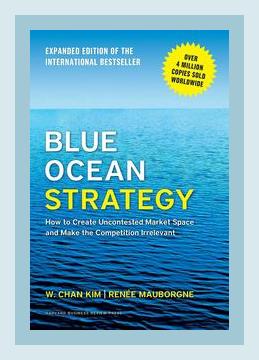Business StrategyBlue Ocean Strategy
Summary: Strategic Innovation: Exploring Blue Ocean Paths by Linda Walker (2018)
Introduction
“Strategic Innovation: Exploring Blue Ocean Paths” by Linda Walker is a comprehensive overview of the Blue Ocean Strategy, which focuses on creating new market spaces and making the competition irrelevant. Walker delves deep into how organizations can transcend traditional competitive approaches to identify untapped opportunities. Throughout the book, she provides a plethora of real-world examples and actionable insights that organizations can leverage to blaze their own trails in the business world.
Chapter 1: Understanding Blue Ocean Strategy
Major Point: Blue Ocean vs. Red Ocean
Walker begins by differentiating between “Red Ocean” and “Blue Ocean” strategies. Red Ocean strategies involve competing in existing markets and beating the competition, while Blue Ocean strategies revolve around creating new, uncontested markets.
Examples:
– Cirque du Soleil’s success: By blending circus and theatrical performances, Cirque du Soleil created a whole new entertainment category, attracting customers who previously never attended traditional circuses.
Actionable Step: Identify areas in your industry that are underserved or overlooked. Create a product or service that offers unique value and targets these uncharted spaces.
Chapter 2: Value Innovation
Major Point: The Cornerstone of Blue Ocean Strategy
Value innovation is about simultaneously pursuing differentiation and low cost, thereby opening up new market space.
Examples:
– Southwest Airlines: By eliminating unnecessary services and creating a point-to-point route system, Southwest Airlines reduced costs and offered low fares, catering to a new market of budget-conscious travelers.
Actionable Step: Evaluate your company’s offerings to find ways to eliminate unnecessary features and simultaneously introduce unique benefits that provide consumers more value for less cost.
Chapter 3: Analytical Tools and Frameworks
Major Point: Strategic Tools
Walker emphasizes the importance of strategic tools like the Strategy Canvas and the Four Actions Framework to identify Blue Ocean opportunities.
Examples:
– Nintendo Wii: Using these tools, Nintendo shifted its focus from hardcore gamers to a broader, family-oriented audience by introducing motion-sensing games.
Actionable Step: Create a Strategy Canvas for your business, plotting your value curves against competitors. Then, apply the Four Actions Framework to see what can be eliminated, reduced, raised, or created to generate new value.
Chapter 4: The Six Paths Framework
Major Point: Reconstruct Market Boundaries
Walker explores how the Six Paths Framework can help businesses systematically explore opportunities beyond existing industry assumptions.
Examples:
– Nespresso: By transforming a low-margin commodity (coffee) into a high-margin offering through a unique capsule system, Nespresso redefined the way consumers perceive and consume coffee.
Actionable Step: Challenge conventional boundaries within your industry using the Six Paths Framework—look across alternative industries, strategic groups, buyer groups, complementary products, functional/emotional appeals, and time.
Chapter 5: Case Studies of Blue Ocean Strategy
Major Point: Practical Applications
Real-world applications of Blue Ocean strategies illustrate how diverse companies have succeeded by creating new demand in attractive market spaces.
Examples:
– iTunes: Apple’s iTunes transformed music purchasing by providing a legal, user-friendly platform for downloading individual songs rather than whole albums.
Actionable Step: Study successful Blue Ocean moves in various industries. Identify commonalities and apply similar innovative thinking to develop your own unique solutions.
Chapter 6: Overcoming Organizational Hurdles
Major Point: Implementing Strategy
Walker discusses how organizations can overcome key hurdles to execute Blue Ocean strategies effectively—cognitive, resource, motivational, and political hurdles.
Examples:
– Ford Model T: Henry Ford overcame cognitive biases by persistently advocating for the mass production of affordable automobiles, radically changing personal transportation.
Actionable Step: Address potential barriers to your Blue Ocean strategy by ensuring effective communication, securing necessary resources, motivating your team, and navigating political dynamics within your organization.
Chapter 7: Building a Blue Ocean Team
Major Point: Assembling the Right Team
Selecting and nurturing a team capable of conceptualizing and executing Blue Ocean strategies is crucial.
Examples:
– Zappos: Tony Hsieh fostered a culture of customer service excellence, aligning every team member with the company’s unique market positioning.
Actionable Step: Focus on hiring and developing a team that is creative, adaptable, and aligned with your strategic vision. Encourage a culture of innovation and continuous improvement.
Chapter 8: Leveraging Data and Technology
Major Point: Data-Driven Decision Making
Walker highlights the role of data and technology in identifying and acting on Blue Ocean opportunities.
Examples:
– Netflix: By leveraging user data to personalize viewing suggestions and original content, Netflix created a new standard for consumption and engagement in the entertainment industry.
Actionable Step: Invest in data analytics and technology tools to gather insights about potential market gaps and consumer needs. Use this information to guide strategic decisions and innovation.
Chapter 9: Scaling and Sustaining Blue Oceans
Major Point: Sustaining Competitive Advantage
Sustaining a Blue Ocean strategy involves continuous innovation and reframing to maintain competitive advantage.
Examples:
– Tesla: By continuously innovating in electric vehicle technology and expanding into energy solutions, Tesla remains a leader in sustainable transportation.
Actionable Step: Regularly revisit and refine your Blue Ocean strategy to adapt to changing market conditions. Foster a culture of continuous innovation within your organization.
Chapter 10: The Future of Blue Ocean Strategy
Major Point: Anticipating the Future
Walker concludes by discussing the need for organizations to future-proof their strategies through foresight and adaptability.
Examples:
– Airbnb: Continually expanding its platform to include ‘Experiences’ in addition to home rentals, Airbnb anticipates the evolving desires of travelers looking for unique, immersive experiences.
Actionable Step: Stay abreast of emerging trends and disruptions in your industry. Encourage proactive thinking and ensure your organization can pivot swiftly in response to new opportunities.
Conclusion
“Strategic Innovation: Exploring Blue Ocean Paths” by Linda Walker provides a robust framework for breaking free from competitive constraints and uncovering new growth opportunities. By blending theoretical insights with practical applications, Walker equips readers with the tools and mindset required to craft and sustain innovative, uncontested market spaces. Whether you’re an entrepreneur looking to disrupt an industry or a corporate leader aiming to rejuvenate your business strategy, Walker’s book offers valuable guidance to navigate the path to Blue Ocean success.
